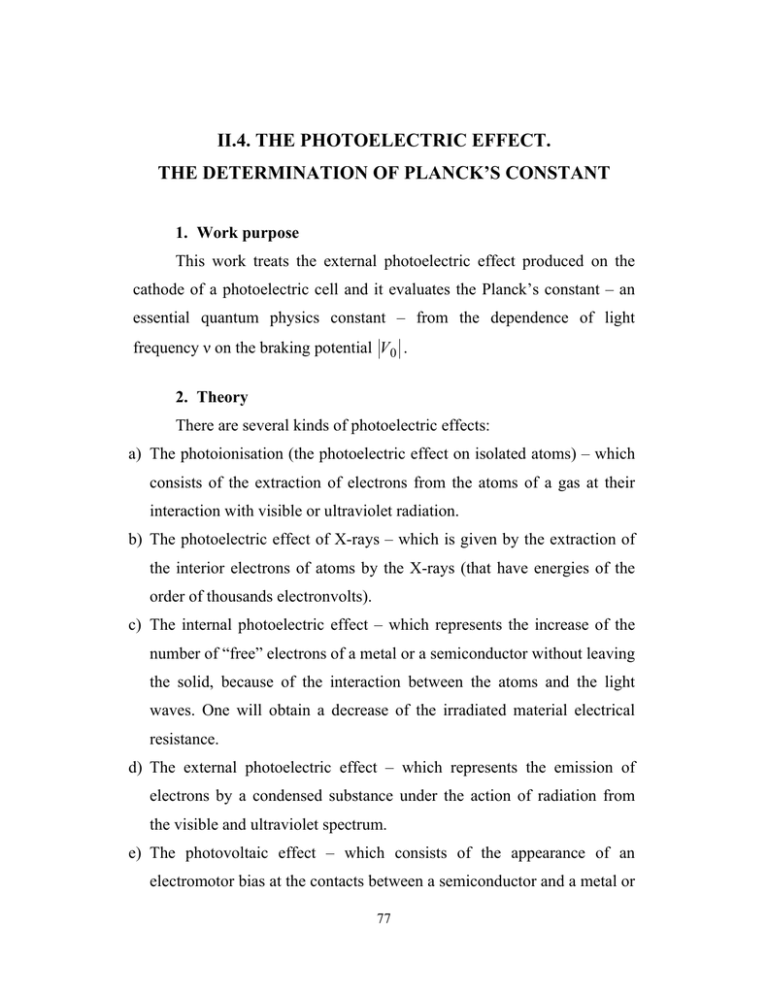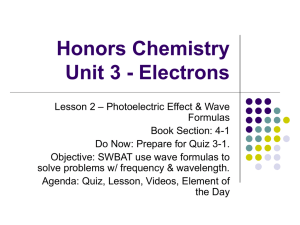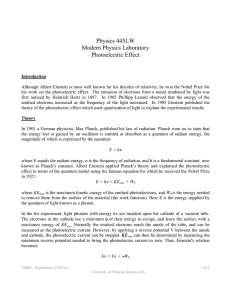II.4. THE PHOTOELECTRIC EFFECT. THE DETERMINATION OF PLANCK’S CONSTANT
advertisement

II.4. THE PHOTOELECTRIC EFFECT. THE DETERMINATION OF PLANCK’S CONSTANT 1. Work purpose This work treats the external photoelectric effect produced on the cathode of a photoelectric cell and it evaluates the Planck’s constant – an essential quantum physics constant – from the dependence of light frequency ν on the braking potential V0 . 2. Theory There are several kinds of photoelectric effects: a) The photoionisation (the photoelectric effect on isolated atoms) – which consists of the extraction of electrons from the atoms of a gas at their interaction with visible or ultraviolet radiation. b) The photoelectric effect of X-rays – which is given by the extraction of the interior electrons of atoms by the X-rays (that have energies of the order of thousands electronvolts). c) The internal photoelectric effect – which represents the increase of the number of “free” electrons of a metal or a semiconductor without leaving the solid, because of the interaction between the atoms and the light waves. One will obtain a decrease of the irradiated material electrical resistance. d) The external photoelectric effect – which represents the emission of electrons by a condensed substance under the action of radiation from the visible and ultraviolet spectrum. e) The photovoltaic effect – which consists of the appearance of an electromotor bias at the contacts between a semiconductor and a metal or 77 between two semiconductors, if the contact region is irradiated with a light beam. This work studies the external photoelectric effect for a metal (the cathode of a photoelectric cell). The laws of the external photoelectric effect were experimentally obtained by Lenard in 1905 and the experimental method was described by Millikan in 1916. Figure 1. A simple circuit is used (see Figure 1). It is formed by: a photoelectric cell, whose cathode C is irradiated with a light beam characterized by the frequency ν and the flow φ; a potentiometer allowing to apply on the cell anode A a voltage V (positive or negative with respect to the cathode); a voltmeter to measure this voltage; a microammeter to measure the photoelectric current I. The current – voltage characteristics for constant frequency and variable flow (φ1 < φ2 < φ3 ) are presented in Figure 2. From these characteristics one can determine the saturation current I s and the braking voltage V0 . The last one stands for canceling the photoelectric current intensity and it is a measure of the maximum photoelectron energy. 78 Figure 2. Maintaining constant the flow Φ and changing the frequency ν of the incident light, one can observe the following: - The photoelectric effect is not produced for a frequency lower than a threshold frequency νt , depending on the cathode material. - The modulus of the braking voltage increases linearly with the frequency (Fig. 3). On this basis, we can infer the following laws for the external photoelectric effect: 1. The saturation intensity of the photoelectric current is directly proportional with the flow of the incident radiation at a constant frequency I s ~ φ . 2. The maximum photoelectron kinetic energy increases linearly with the radiation frequency and does not depend on their flow ( Ek max = aν + b) . The slope of this line does not depend on the experimental conditions (a is an universal constant). 3. The external photoelectric effect is produced only if the incident radiation frequency is greater than or equal with a minimum value, called threshold frequency νt , specific for each material. 79 4. The external photoelectric effect is practically instantaneous. Figure 3. These laws appear to be in total contradiction with the electromagnetic wave theory of the light, but they become obvious in the frame of the corpuscular theory of light. Their theoretical explanation was given by Einstein in 1905. This theory considers the light as a flow of photons having the energy hν and the momentum h / λ (h is Planck’s constant, ν represents the frequency and λ is the light wavelength.). Using this fact, Einstein showed that the photoelectric effect corresponds to the energy transfer from a photon to an electron, in other words represents a plastic collision between the photon and the electron, with photon annihilation. If the energy of the photon hν is greater than the extraction work, the emitted electron leaves the substance with a kinetic energy Ek . The energy conservation theorem applied to this effect leads to the following formula: hν = We + Ek , (1) where We is the extraction work (the energy needed for the electron to leave the substance). The equation (1) is called Einstein’s equation. In the 80 case of the threshold frequency, the electron kinetic energy is zero and we have: hνt = We . (2) The determination of the kinetic energy Ek for the emitted electrons is made by using the braking electric field method: on the photoelectric cell anode is applied a negative bias with respect to the cathode. This leads to the braking of the electrons and the decrease of the photoelectric current intensity I. The maximum value of the modulus of this bias is called braking voltage and is quoted V0 . It corresponds to the case when no electron reaches the anode and I becomes zero. Then mv 2 Ek = = e V0 , 2 (3) where e is the elementary charge. From the equations (1 – 3) we obtain: hν = hνt + e V0 (4) and therefore: V0 = h h ν − νt . e e (5) The last formula explains the second and the third laws of the external photoelectric effect and the experimental results shown in Figure 3. The braking voltage V0 is experimentally determined for different frequencies, the straight line corresponding to the equation V0 = f (ν) is drawn and from its slope the Planck’s constant is computed. 3. Experimental set-up. The experimental set-up whose draft is shown in Fig. 4 contains: 81 Figure 4. - A Hg lamp (L) used as the radiation source. - A vacuum photoelectric cell (PC) placed inside an dark box (in order to eliminate other radiation). - Three “monochromatic” filters quoted with A, B, C, which select radiation with certain wave lengths λ or frequencies ν from the light emitted by the lamp L – the values being indicated in the experimental data table. - A preamplifier (PA) equipped with a compensatory potentiometer (CP). - A source of stabilized voltage (S1), which feeds the preamplifier. - A source of variable voltage (S2) for applying the braking voltage Vb on the anode. - A galvanometer for the measurement of a voltage U g proportional to the photovoltaic current I. 4. Working procedure. 4.1. The lamp L and the sources S1, S2 are plugged in (220 V). 4.2. A voltage between 10 and 15 V will be settled for S1. 4.3. Although the photoelectric cell is covered with black paper, a galvanometer voltage U g 0 appears (dark current). This one needs to be 82 compensated using the potentiometer CP from the preamplifier. By alternatively modifying the potentiometer CP and the source S1 potentiometer, the value U g 0 = 0 is obtained (the galvanometer zero is fixed). 4.4. The box cover containing the photoelectric cell is removed and the filter A is placed in the beam emitted by lamp L. The black paper is removed and the cover is put back. WARNING: The light emitted from the mercury lamp is not allowed to drop directly on the photoelectric cell, but only through a filter. 4.5. Using the source S2, a variable braking potential Vb (increased in steps of no more than 0.25 V) is applied on the photoelectric cell and for each value one marks the galvanometer voltage U g , that is proportional with the photoelectric current, until it becomes zero. 4.6. The measurements for the other filters are repeated, starting with rechecking the zero of the galvanometer (step 4.3.). 4.7. The results are put in Table 1: Table 1 Vb (V) 0 0.25 0.50 0.75 ... Filter A B C 5. Experimental data processing. 5.1. As at low voltages a vacuum diode satisfies the 3/2 law, one represents on millimetric paper Ug 2 / 3 = f ( Vb ) for the three filters A, B, C. The central part of each curve is practically linear. 83 5.2. The intersections of the linear parts of the experimental curves with the Vb axe give the values of the braking voltage V0 for each of the three filters. These values are corrected with a coefficient k = 1 / 4 . 5.3. The obtained data are put in Table 2: Table 2 Filter A (BLUE) B (GREEN) C (YELLOW) λ (Å) 4360 5460 5770 ν (1014 Hz) 6,88 5,49 5,20 V0 (V) V0c (V) 5.4. The corrected braking voltage modulus, V0c , is represented on millimetric paper as function of the radiation frequency ν. A straight line is obtained. 5.5. The line slope is computed and equalized with h / e as in Eq. (5). This way we obtain the Planck’s constant. 6. Work importance and applications The most important applications of the photoelectric effect are: photoelectric cell, photoelectric relays, photomultipliers and memory tubes. In the theoretical field the photoelectric effect, together with other phenomena, leaded to the elaboration of the light quantum theory. 84







